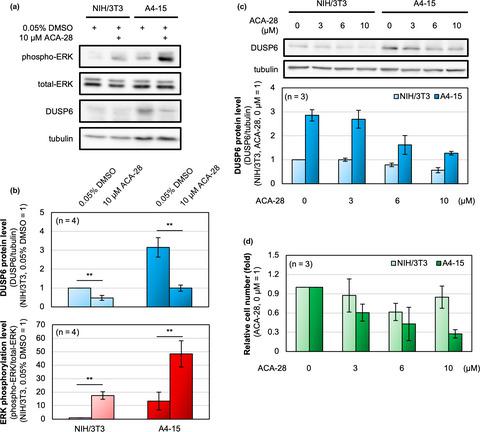当前位置:
X-MOL 学术
›
Genes Cells
›
论文详情
Our official English website, www.x-mol.net, welcomes your feedback! (Note: you will need to create a separate account there.)
Down‐regulation of dual‐specificity phosphatase 6, a negative regulator of oncogenic ERK signaling, by ACA‐28 induces apoptosis in NIH/3T3 cells overexpressing HER2/ErbB2
Genes to Cells ( IF 2.1 ) Pub Date : 2020-11-29 , DOI: 10.1111/gtc.12823 Yuki Kanda 1 , Ayami Mizuno 1 , Teruaki Takasaki 1 , Ryosuke Satoh 1 , Kanako Hagihara 1 , Takashi Masuko 2 , Yuichi Endo 2 , Genzoh Tanabe 3 , Reiko Sugiura 1, 4
Genes to Cells ( IF 2.1 ) Pub Date : 2020-11-29 , DOI: 10.1111/gtc.12823 Yuki Kanda 1 , Ayami Mizuno 1 , Teruaki Takasaki 1 , Ryosuke Satoh 1 , Kanako Hagihara 1 , Takashi Masuko 2 , Yuichi Endo 2 , Genzoh Tanabe 3 , Reiko Sugiura 1, 4
Affiliation

|
Dual‐specificity phosphatase 6 (DUSP6) is a key negative feedback regulator of the member of the RAS‐ERK MAPK signaling pathway that is associated with cellular proliferation and differentiation. Deterioration of DUSP6 expression could therefore result in deregulated growth activity. We have previously discovered ACA‐28, a novel anticancer compound with a unique property to stimulate ERK phosphorylation and induce apoptosis in ERK‐active melanoma cells. However, the mechanism of cancer cell‐specific‐apoptosis by ACA‐28 remains obscure. Here, we investigated the involvement of DUSP6 in the mechanisms of the ACA‐28‐mediated apoptosis by using the NIH/3T3 cells overexpressing HER2/ErbB2 (A4‐15 cells), as A4‐15 exhibited higher ERK phosphorylation and are more susceptible to ACA‐28 than NIH/3T3. We showed that A4‐15 exhibited high DUSP6 protein levels, which require ERK activation. Notably, the silencing of the DUDSP6 gene by siRNA inhibited proliferation and induced apoptosis in A4‐15, but not in NIH/3T3, indicating that A4‐15 requires high DUSP6 expression for growth. Importantly, ACA‐28 preferentially down‐regulated the DUSP6 protein and proliferation in A4‐15 via the proteasome, while it stimulated ERK phosphorylation. Collectively, the up‐regulation of DUSP6 may exert a growth‐promoting role in cancer cells overexpressing HER2. DUSP6 down‐regulation in ERK‐active cancer cells might have the potential as a novel cancer measure.
中文翻译:

ACA-28对双特异性磷酸酶6(致癌ERK信号的负调节剂)的下调诱导过表达HER2 / ErbB2的NIH / 3T3细胞凋亡
双重特异性磷酸酶6(DUSP6)是RAS‐ERK MAPK信号通路成员与细胞增殖和分化相关的关键负反馈调节剂。因此,DUSP6表达的恶化可能导致生长活性失调。我们以前发现过ACA-28,这是一种新型的抗癌化合物,具有刺激ERK磷酸化并诱导ERK活性黑素瘤细胞凋亡的独特特性。但是,ACA-28癌细胞特异性凋亡的机制仍然不清楚。在这里,我们通过使用过度表达HER2 / ErbB2的NIH / 3T3细胞(A4-15细胞)研究了DUSP6在ACA-28介导的凋亡机制中的参与,因为A4-15表现出较高的ERK磷酸化并且更易受ACA‐28比NIH / 3T3高。我们发现A4-15表现出较高的DUSP6蛋白水平,需要激活ERK。值得注意的是,siRNA对DUDSP6基因的沉默抑制了A4-15中的增殖并诱导了细胞凋亡,但在NIH / 3T3中却没有,表明A4-15需要高DUSP6表达才能生长。重要的是,ACA-28在刺激ERK磷酸化的同时,优先通过蛋白酶体下调DUSP6蛋白和A4-15中的增殖。总的来说,DUSP6的上调可能在过表达HER2的癌细胞中发挥促进生长的作用。在ERK活性癌细胞中DUSP6的下调可能具有作为一种新的癌症手段的潜力。ACA-28优先通过蛋白酶体下调DUSP6蛋白和A4-15中的增殖,同时刺激ERK磷酸化。总的来说,DUSP6的上调可能在过表达HER2的癌细胞中发挥促进生长的作用。在ERK活性癌细胞中DUSP6的下调可能具有作为一种新的癌症手段的潜力。ACA-28优先通过蛋白酶体下调DUSP6蛋白和A4-15中的增殖,同时刺激ERK磷酸化。总的来说,DUSP6的上调可能在过表达HER2的癌细胞中发挥促进生长的作用。在ERK活性癌细胞中DUSP6的下调可能具有作为新的癌症检测手段的潜力。
更新日期:2021-02-05
中文翻译:

ACA-28对双特异性磷酸酶6(致癌ERK信号的负调节剂)的下调诱导过表达HER2 / ErbB2的NIH / 3T3细胞凋亡
双重特异性磷酸酶6(DUSP6)是RAS‐ERK MAPK信号通路成员与细胞增殖和分化相关的关键负反馈调节剂。因此,DUSP6表达的恶化可能导致生长活性失调。我们以前发现过ACA-28,这是一种新型的抗癌化合物,具有刺激ERK磷酸化并诱导ERK活性黑素瘤细胞凋亡的独特特性。但是,ACA-28癌细胞特异性凋亡的机制仍然不清楚。在这里,我们通过使用过度表达HER2 / ErbB2的NIH / 3T3细胞(A4-15细胞)研究了DUSP6在ACA-28介导的凋亡机制中的参与,因为A4-15表现出较高的ERK磷酸化并且更易受ACA‐28比NIH / 3T3高。我们发现A4-15表现出较高的DUSP6蛋白水平,需要激活ERK。值得注意的是,siRNA对DUDSP6基因的沉默抑制了A4-15中的增殖并诱导了细胞凋亡,但在NIH / 3T3中却没有,表明A4-15需要高DUSP6表达才能生长。重要的是,ACA-28在刺激ERK磷酸化的同时,优先通过蛋白酶体下调DUSP6蛋白和A4-15中的增殖。总的来说,DUSP6的上调可能在过表达HER2的癌细胞中发挥促进生长的作用。在ERK活性癌细胞中DUSP6的下调可能具有作为一种新的癌症手段的潜力。ACA-28优先通过蛋白酶体下调DUSP6蛋白和A4-15中的增殖,同时刺激ERK磷酸化。总的来说,DUSP6的上调可能在过表达HER2的癌细胞中发挥促进生长的作用。在ERK活性癌细胞中DUSP6的下调可能具有作为一种新的癌症手段的潜力。ACA-28优先通过蛋白酶体下调DUSP6蛋白和A4-15中的增殖,同时刺激ERK磷酸化。总的来说,DUSP6的上调可能在过表达HER2的癌细胞中发挥促进生长的作用。在ERK活性癌细胞中DUSP6的下调可能具有作为新的癌症检测手段的潜力。



























 京公网安备 11010802027423号
京公网安备 11010802027423号